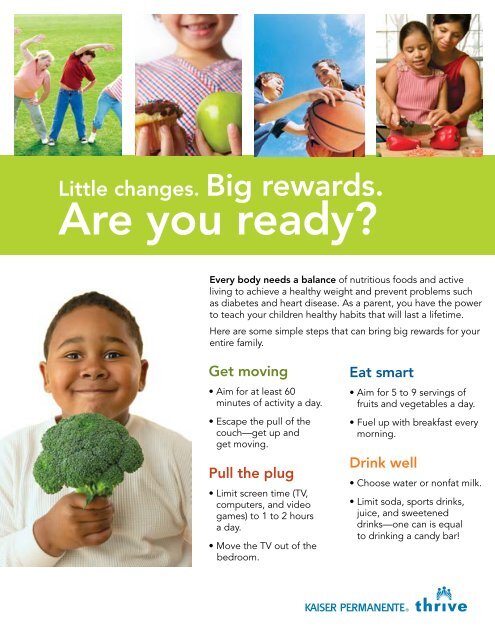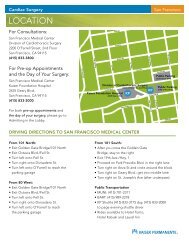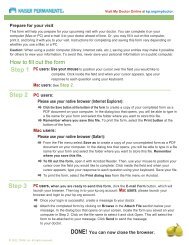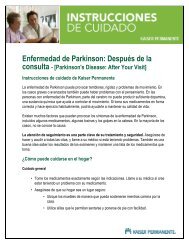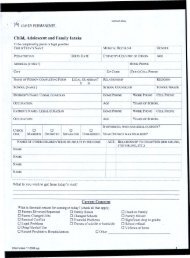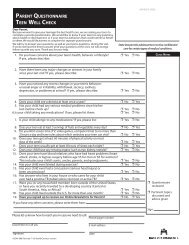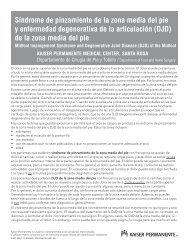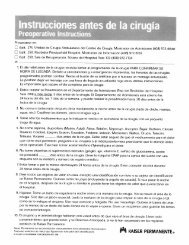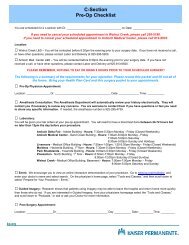Are you ready? - My Doctor Online The Permanente Medical Group
Are you ready? - My Doctor Online The Permanente Medical Group
Are you ready? - My Doctor Online The Permanente Medical Group
Create successful ePaper yourself
Turn your PDF publications into a flip-book with our unique Google optimized e-Paper software.
Little changes. Big rewards.<br />
<strong>Are</strong> <strong>you</strong> <strong>ready</strong>?<br />
Every body needs a balance of nutritious foods and active<br />
living to achieve a healthy weight and prevent problems such<br />
as diabetes and heart disease. As a parent, <strong>you</strong> have the power<br />
to teach <strong>you</strong>r children healthy habits that will last a lifetime.<br />
Here are some simple steps that can bring big rewards for <strong>you</strong>r<br />
entire family.<br />
Get moving<br />
• Aim for at least 60<br />
minutes of activity a day.<br />
• Escape the pull of the<br />
couch—get up and<br />
get moving.<br />
Pull the plug<br />
• Limit screen time (TV,<br />
computers, and video<br />
games) to 1 to 2 hours<br />
a day.<br />
• Move the TV out of the<br />
bedroom.<br />
Eat smart<br />
• Aim for 5 to 9 servings of<br />
fruits and vegetables a day.<br />
• Fuel up with breakfast every<br />
morning.<br />
Drink well<br />
• Choose water or nonfat milk.<br />
• Limit soda, sports drinks,<br />
juice, and sweetened<br />
drinks—one can is equal<br />
to drinking a candy bar!
An example of a healthy plate<br />
1 /2 fruits and vegetables<br />
1 /4 whole grains<br />
1 /4 lean protein<br />
How can I help my child be as healthy<br />
as possible?<br />
Enjoy family mealtime<br />
• Start with a healthy breakfast every day, and create a family routine<br />
for meal and snack times.<br />
• Eat together as a family when possible with the TV off.<br />
• Be a role model for healthy eating, and have everyone eat the<br />
same foods—avoid preparing separate meals for <strong>you</strong>r child.<br />
• Make fruit the everyday dessert.<br />
Let <strong>you</strong>r child decide how much to eat<br />
• You decide what is served; <strong>you</strong>r child decides when he or she<br />
has had enough.<br />
• Avoid comments about how much or what <strong>you</strong>r child is eating.<br />
• Growth slows during early school years—don’t force<br />
bigger portions.<br />
Plan ahead and keep healthy food within reach<br />
• Stock a cupboard with healthy after-school snacks.<br />
• Let <strong>you</strong>r child shop and cook with <strong>you</strong>.<br />
Offer a variety of healthy foods<br />
• Serve brightly colored fruits and veggies—they tend to be<br />
more nutritious.<br />
• Choose whole-grains (such as brown rice and pasta), whole wheat<br />
breads and low-sugar cereals most of the time.<br />
• Shop for lean meats, trimming extra fat before serving.<br />
Choose not to use sweets as rewards<br />
• Reward instead with kind words and hugs, or non-food items<br />
like stickers.<br />
Play hard and rest well!<br />
• Set a good example, and enjoy active time with <strong>you</strong>r family.<br />
• Balance the activity with good sleep. Children and adults who<br />
sleep less tend to weigh more and have less energy for play.<br />
This information is not intended to diagnose health problems or to take the place of medical advice or care <strong>you</strong> receive from <strong>you</strong>r physician or other<br />
health care professional. If <strong>you</strong> have persistent health problems, or if <strong>you</strong> have additional questions, please consult with <strong>you</strong>r doctor.<br />
©2012 <strong>The</strong> <strong>Permanente</strong> <strong>Medical</strong> <strong>Group</strong>, Inc. All rights reserved. Regional Health Education.<br />
90433 (2-12)<br />
Children come in all sizes<br />
• Body Mass Index (BMI) looks<br />
at <strong>you</strong>r child’s height, weight,<br />
age and sex and plots it<br />
onto a growth chart. Children<br />
whose BMI is near the higher<br />
end of the growth chart (85th<br />
percentile and above) are<br />
considered to be at greater<br />
risk of diabetes and heart<br />
disease.<br />
• However, BMI is only one of<br />
the tools used to determine<br />
if <strong>you</strong>r child’s weight is a<br />
healthy one; there are no<br />
“ideal” heights and weights<br />
for children.<br />
• Let <strong>you</strong>r children know <strong>you</strong><br />
love them whatever their size.<br />
• Avoid using words like “skinny”<br />
or “fat,” or teasing them<br />
about their weight.<br />
• Explain that <strong>you</strong> want them<br />
to be healthier, and that the<br />
whole family is going to work<br />
on improving everyone’s eating<br />
and activity habits.<br />
<strong>Online</strong> Resources:<br />
• Resources right on <strong>you</strong>r<br />
doctor’s home page:<br />
kp.org/mydoctor<br />
• Nutrition and activity tips<br />
and challenges:<br />
letsmove.gov<br />
• Food and nutrition<br />
information:<br />
nutrition.gov<br />
• USDA information<br />
and resources:<br />
choosemyplate.gov


